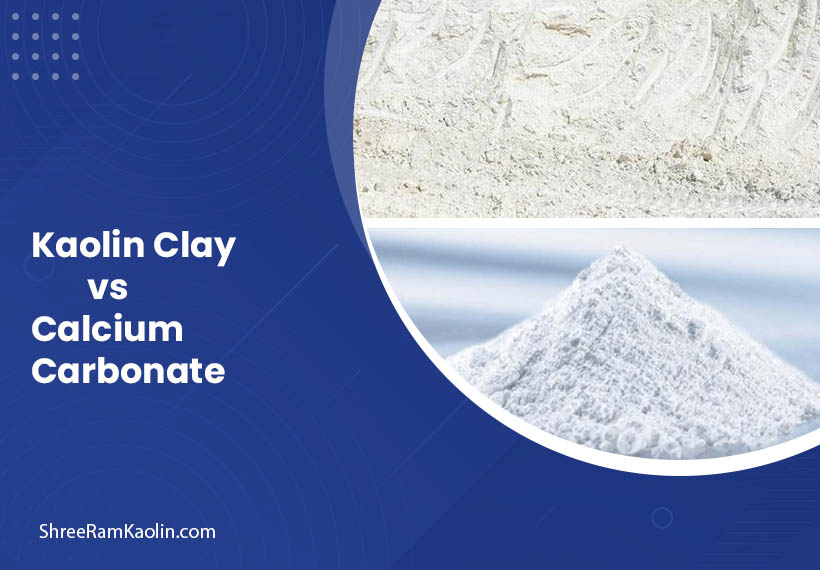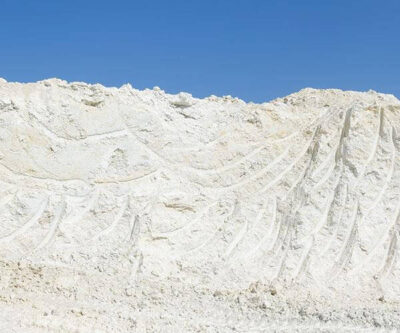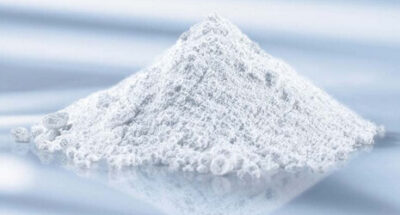Kaolin Clay vs Calcium Carbonate

Curious about the white powders that show up in everything from your favorite face mask to the paper you write on? Kaolin clay and calcium carbonate powders are two widely utilized mineral powders across multiple industries. At first glance, these minerals might appear similar; however, each mineral boasts unique properties which make them suitable for specific uses. So let’s dive deep into their fascinating world to uncover all their differences, similarities, and benefits!
Understanding Kaolin Clay

Kaolin clay (sometimes known as China clay) has long been utilized by various civilizations for various applications. Unbeknownst to many people, kaolin plays an unsung part in everyday products they rely on without much thought being given its contribution.
Origin and Composition of Kaolin Clay
Kaolin clay is a hydrated aluminum silicate (Al₂Si₂O₅(OH)₄) formed primarily through the weathering of aluminum-rich minerals like feldspar. Kaolin derives its name from “Gaoling”, an area in China where this clay has been mined for generations. What sets kaolin apart from other clay types is its fine particle size and plate-like structures found under magnification.
Kaolin is composed primarily of the mineral kaolinite; however, depending on its source it may contain various amounts of other minerals such as quartz, mica and feldspar which gives different varieties unique properties.
Physical Properties of Kaolin Clay
Kaolin clay boasts an earthy aroma and mild temperament, unlike many clays which swell dramatically when wet; by contrast, kaolin maintains a relatively stable structure when mixed with water; its fine particle size also make this material highly useful in numerous applications.
Color and Texture Characteristics
Kaolin clay in its purest state is bright white in appearance; however, depending on impurities present, its hue may range from cream-white to light gray or even slightly pink depending on its hue. When mixed with water it forms an adhesive paste which spreads readily but doesn’t become as plastic or malleable like other clay types.
The World of Calcium Carbonate

Have you taken an antacid pill or seen marble sculptures and come into contact with calcium carbonate? Calcium carbonate occurs throughout nature and has become one of humanity’s primary materials, used extensively across industry sectors for numerous applications.
Natural and Synthetic Forms of Calcium Carbonate
Calcium carbonate (CaCO₃)occurs naturally in many forms such as limestone, marble and chalk; eggshells, seashells and coral contain this mineral too. Industrial applications for (CaCO₃) typically fall into two main categories. Ground Calcium Carbonate (GCC) – directly mined and processed from natural sources
- Precipitated Calcium Carbonate (PCC) – synthetically produced through chemical processes
Synthetic production enables manufacturers greater control over purity, particle size and shape which may be vitally important in specific applications.
Chemical Composition and Properties
Calcium carbonate, at its core, consists of calcium carbonate arranged crystalline structure made up of calcium carbonate and oxygen atoms. One of its notable characteristics is how well it reacts with acids releasing carbon dioxide gas which will then cause your science fair volcano to erupt!
Calcium carbonate has a higher density and less electrically charged structure compared to kaolin clay, as well as being alkaline with an approximate pH level of 9 (compared with neutrality for the latter).
Different Grades and Their Applications
The versatility of calcium carbonate stems partly from the different grades available:
- Ultra-fine powder grades are used in high-quality paints and coatings
- Food-grade calcium carbonate appears in supplements and as an anti-caking agent
- Technical grades serve in plastics, adhesives, and sealants
- Agricultural grades help adjust soil pH for farming
Each grade has specific particle size distributions and purity levels tailored to its intended use.
Comparing Physical Properties
Understanding their physical characteristics becomes key when selecting between kaolin clay and calcium carbonate for any specific use.
Particle Size and Structure Differences
Under magnification, these minerals exhibit distinct physical traits. Kaolin clay particles feature plate-like structures which stack, while calcium carbonate crystals tend to have more blocky or rhombohedral shapes.
Kaolin usually comes in particle sizes that span from 0.1-10 microns while calcium carbonate can be processed to create different particle sizes ranging between 1-70 microns for processing purposes. These differences have profound impacts on everything from how each material feels against your skin to their dispersion in liquid formulations.
Absorption and Adsorption Capabilities
Here’s where it gets exciting! Kaolin clay excels at adsorption – its ability to attract substances onto its surface and extract impurities through skincare applications. As such, this makes it especially efficient at drawing out impurities from skin surfaces.
Calcium carbonate exhibits lower adsorptive properties but excellent liquid absorption properties; this explains why kaolin is often preferred in detoxifying face masks while calcium carbonate might be chosen for moisture control in some products.
Industrial Applications Compared
Both minerals play a pivotal role across numerous industries, yet their roles vary according to their individual properties.
Paper Manufacturing Usage
Both minerals play essential roles in the paper industry. Kaolin clay serves primarily as a coating pigment used on glossy magazines to give images depth. Its plate-like particles align into uniform surfaces that take ink beautifully.
Calcium carbonate serves a major purpose as an additive in paper manufacturing processes that has gained market share during recent decades due to shifting from acidic papermaking processes. Calcium carbonate’s use as filler has increased substantially alongside shifting from acidic processes.
Environmental Considerations
In our increasingly eco-conscious world, the environmental impact of materials matters more than ever.
Mining Impact and Sustainability
Both minerals require mining, which invariably alters landscapes and ecosystems. Kaolin mining generally employs open-pit techniques which disrupt vegetation cover while calcium carbonate mining (especially limestone quarrying ) often alters environments as a result.
On a positive note, both industries have taken significant strides forward with reclamation practices. Former kaolin mines have been converted to lakes or wildlife habitats while limestone quarries may be transformed into recreational spaces or wetland environments.
Biodegradability and Eco-Friendly Aspects
Kaolin and calcium carbonate, being natural minerals, are inherently biodegradable and non-toxic when returned to ecosystems – neither remaining as harmful microplastics or leaching dangerous chemicals into our environment.
Calcium carbonate also offers another eco-benefit: in some applications it can help lower carbon footprint by replacing petroleum-derived materials, for instance by being added as filler in plastics to decrease synthetic polymer usage.
Cost Analysis and Market Trends
Calcium carbonate usually outshone its counterpart kaolin clay when it comes to economic considerations; its global availability makes processing it cheaper; thus leading some applications where both properties overlap to prefer calcium carbonate as their material choice.
The market for both minerals continues to grow, driven by:
- Expanding paper markets in developing countries
- Growing demand for natural ingredients in personal care
- Increasing use of mineral fillers in plastics to reduce petroleum dependency
- Rising construction activities that use both minerals in various materials
Kaolin can often command higher prices than calcium carbonate for specialty ceramic and paper coating applications that rely on its unique properties that cannot be easily substituted with alternative substances.
Making the Right Choice for Your Needs
With all this information at your disposal, how can you select an optimal mineral for your specific use case? Keep a few factors in mind to assist in making this determination:
- pH requirements – Kaolin is more pH neutral, while calcium carbonate is alkaline
- Particle characteristics needed – Plate-like or blocky?
- Surface interaction desired – Adsorptive or absorptive?
- Processing compatibility – Will the mineral react with other ingredients?
- Cost constraints – Budget considerations may favor calcium carbonate
- Environmental factors – Local availability and sustainability concerns.
For many household applications, here’s a quick guide:
- For DIY paint: Calcium carbonate often provides better opacity
- For ceramic projects: Kaolin is traditional and offers better workability
- For garden soil amendment: Calcium carbonate effectively raises pH in acidic soils
Conclusion
Kaolin clay and calcium carbonate appear similar, yet offer distinct properties that make them highly valued minerals in many applications – from printer paper to face masks! While both minerals possess useful characteristics that enhance our daily lives – Kaolin excels where adsorptive properties and plate-like particles are required while calcium carbonate excels where alkalinity, opacity and cost-effectiveness are priorities – providing many applications where their unique attributes come to the fore.
Understanding these distinctions enables manufacturers, formulators and even DIY enthusiasts to select the ideal mineral for specific requirements. As environmental concerns increase, both industries continue moving toward more responsible practices that ensure ancient minerals will continue meeting modern demands far into the future.
As soon as you come across white powder ingredients on a product label, you will gain greater appreciation of their scientific properties and versatility.

